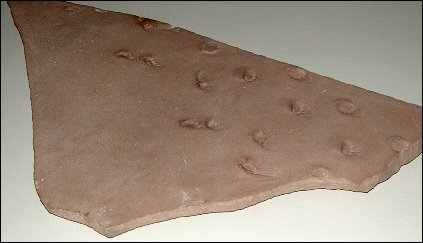

We usually think of bones, or maybe shells, when we think of fossils, but fossils are much more diverse. When you think about it, you remember that amber is the fossilized sap of trees, and chunks of fossil wood abound in such places as the Petrified Forest of Arizona. You've probably also seen pictures of dinosaur trackways, preserved in rock millions of years old.
The Chihuahuan Desert has its share of fossil footprints, some dating from the time that man in the Southwest overlapped with now-extinct creatures. Some of the more dramatic are known from White Sands, for instead of being sunken into the soil, these stick up above the ground. One trackway shows a number of footprints of a mammoth. As the heavy animal's feet sunk into moist ground, the gypsum-laden soil was compressed. Covered and protected by blowsand, the sunken prints persisted until unsealed by erosion in more recent time.
Sitting on columns of compressed soil, the tracks remained as pedestals
as the ground around them washed away--footprints walking across a surface long since
vanished.

Contributor: Arthur H. Harris, Laboratory for Environmental Biology, Centennial Museum, University of Texas at El Paso.
Desert Diary is a joint production of the Centennial Museum and KTEP National Public Radio at the University of Texas at El Paso.

Footprints of a small, Jurassic dinosaur, Ornitholestes. Centennial Museum specimen.